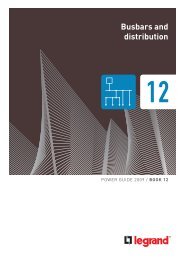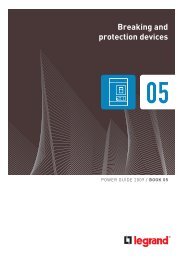You also want an ePaper? Increase the reach of your titles
YUMPU automatically turns print PDFs into web optimized ePapers that Google loves.
3<br />
22<br />
RISK FACTORS<br />
successfully concluded at a nominal cost, could have a material<br />
adverse effect on the Group’s reputation for safety and quality.<br />
Any product liability claims or product recalls could have an<br />
adverse effect on its business, fi nancial condition, results of<br />
operations or cash fl ows.<br />
The Group may incur environmental liability and investment<br />
expenses in connection with the Group’s past, present<br />
and future operations.<br />
The Group’s activities, like those of similar companies, are subject<br />
to extensive and increasingly stringent environmental laws and<br />
regulations regarding, for example, air emissions, asbestos, noise,<br />
health and safety, the use and handling of hazardous waste or<br />
materials, waste disposal and the remediation of environmental<br />
contamination. In particular, European Union Directive 2002/96/EC<br />
dated January 27, 2003 on Waste Electrical and Electronic<br />
Equipment (WEEE), which was transposed into French law by<br />
Decree No. 2005-829, dated July 20, 2005, aims to organize and<br />
improve the management of electrical and electronic equipment<br />
waste and is likely to have an impact on the Group’s operations<br />
(see chapter 6 of this <strong>reference</strong> <strong>document</strong>).<br />
The Group has developed an environmental risk prevention and<br />
measurement policy implemented through environmental audits<br />
which are subsequently reviewed and analyzed by the Group’s<br />
environmental risk management department. The implementation<br />
of this policy, which aims to evaluate preventable risks and to<br />
implement the actions necessary to control them, is a part of the<br />
Group’s efforts to comply with applicable laws, particularly with<br />
respect to environmental protection and pollution control laws.<br />
Therefore, in the context of ISO 14001 certifi cation, the Group has<br />
defi ned an environmental risk identifi cation policy (see chapter 6<br />
of this <strong>reference</strong> <strong>document</strong>). The Group sets up provisions on its<br />
fi nancial statements when environmental assessments are made<br />
or remedial efforts are probable and the costs can be reasonably<br />
estimated.<br />
Notwithstanding the above, the Group may be required to pay<br />
potentially significant fines or damages as a result of past,<br />
present or future violations of applicable environmental laws<br />
and regulations, even if these violations occurred prior to the<br />
acquisition of companies or operations by <strong>Legrand</strong>. Courts,<br />
regulatory authorities or third parties could also require, or seek<br />
to require, <strong>Legrand</strong> to, on the one hand, undertake investigations<br />
and/or implement remedial measures regarding either current or<br />
historical contamination, of current or former facilities or offsite<br />
disposal facilities, and, on the other hand, curtail operations or<br />
temporarily or permanently close facilities in connection with<br />
applicable environmental laws and regulations. The Group may<br />
also become subject to claims for violations of environmental<br />
law. For example, it currently has decontamination obligations<br />
concerning a site in Pont-à-Mousson (France) and a site in<br />
REFERENCE DOCUMENT <strong>2007</strong> - legrand<br />
< Contents ><br />
Syracuse (United States) for which provisions have been made<br />
in a total amount of approximately €3 million. Any of these<br />
actions may harm the Group’s reputation and adversely affect<br />
its operations, financial condition, results of operations and<br />
cash fl ows. <strong>Legrand</strong> has made and will continue to make capital<br />
expenditures to comply with applicable environmental laws and<br />
applicable regulations as they continue to change. If <strong>Legrand</strong> is<br />
unable to recover these expenditures through higher prices, its<br />
profi tability or cash fl ows could be affected.<br />
Moreover, regulatory authorities could suspend the Group’s<br />
operations if it fails to comply with relevant regulations, and/or<br />
may not renew the permits or authorizations the Group requires<br />
to operate. They could also mandate upgrades or changes to its<br />
manufacturing facilities that could result in signifi cant costs to<br />
<strong>Legrand</strong>.<br />
The Group’s competitors may have more signifi cant fi nancial<br />
and marketing resources and therefore may be able to launch<br />
new products and systems more quickly and at lower prices<br />
than <strong>Legrand</strong>. This could reduce the Group’s market share.<br />
The market for the Group’s products is competitive in terms of<br />
pricing, product and service quality, development and timing<br />
of new product launches. The Group’s competitors include<br />
specialized companies acting on a national level and divisions of<br />
large-scale multinational companies, such as Schneider Electric,<br />
ABB, Siemens, General Electric, Matsushita Group, Eaton and<br />
Honeywell International (see paragraph 5.1.3 of this <strong>reference</strong><br />
<strong>document</strong>) which may, due to their size, have superior fi nancial<br />
and marketing resources compared to <strong>Legrand</strong>. The Group’s<br />
competitors could be able to launch products with superior<br />
characteristics or at lower prices, to integrate products and<br />
systems more effectively than <strong>Legrand</strong> does, to secure long-term<br />
agreements with some of the Group’s customers or to acquire<br />
companies targeted for acquisition by <strong>Legrand</strong>. The Group could<br />
lose market share if it is not able to offer prices, technologies<br />
or quality which are at least comparable to those offered by its<br />
competitors or if it does not take advantage of new business<br />
opportunities arising from acquisitions. The Group’s net sales<br />
and profi tability could be consequently affected. Furthermore, in<br />
order to preserve its competitiveness, the Group must regularly<br />
commit resources prior to the launch of a new or upgraded<br />
product line, which, if not as successful as expected, might not<br />
allow the Group to recoup the expenses incurred.<br />
In particular, global competitors may be better positioned to<br />
develop superior product features and technological innovations.<br />
These competitors may also benefit from better financing<br />
conditions for their product development investments and the<br />
Group could be forced to obtain fi nancing on less advantageous<br />
terms to fund the investments necessary to remain competitive.<br />
In addition, smaller local competitors could benefi t from better<br />
1<br />
2<br />
3<br />
4<br />
5<br />
6<br />
7<br />
8<br />
9<br />
10<br />
11<br />
12<br />
13<br />
CT<br />
A








